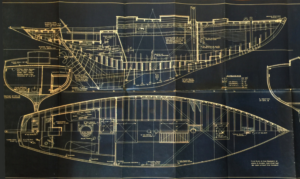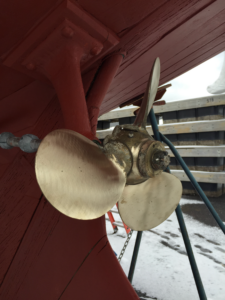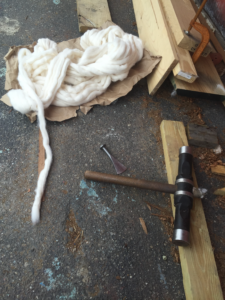Gitana is a historic wooden sailing yacht built in 1936. She was built using traditional methods for wooden ship building. Her original purpose was sailboat racing with the owner and a small crew in coastal and ocean conditions. The vessel is currently docked in the lower harbor of New Rochelle and remains in largely original condition. Gitana is listed in the National Register of Historic Places by the United States National Park Service. Below is a description of the architect, the boat and it’s historic significance.
Naval Architect John Alden

Gitana’s principal designer, the naval architect John Gale Alden (1884-1962), could be considered the godfather of modern American yacht design. His predecessors Starling Burgess and Nathaniel Herreshoff are well known for building large yachts for a wealthy social elite competing for the America’s Cup yachting trophy. Alden, in contrast, pioneered the evolution of smaller boats from working sailing ships to the compact leisure and competitive racing yachts that are in use today. His designs were originally based on the New England fisheries schooners and carried a good amount of speed in open water conditions, as shown by victories of his own boats in the Newport-Bermuda ocean races of 1923, 1926 and 1932. The top four finishers of the 1932 race were Alden’s designs, establishing him an internationally recognized leader in his field. Alden produced the plans for almost 1000 vessels during his active career. He was inducted into the National Sailing Hall of Fame in 2013 and Alden’s yacht designs are documented and collected by the Heart Nautical Collection of the Museum of the MIT in Cambridge, Massachusetts.
Their working boat pedigree made his yachts easy to handle by a small crew, seaworthy and devoid of any excesses in design or materials. These qualities paved the way for recreational sailing achievable by a wider public, and eventually, the post WW II middle class. Of the pre-war fleet of Alden’s designs that numbered in the low thousands, many are still afloat after undergoing complete rebuilds.
The Ship
Gitana is a Bermuda-rigged Yawl of 40 feet in length and a displacement of 26,000 lbs. Her main mast is 56 feet tall; she carries approximately 700 square feet of sail area upwind and almost 1000 square feet downwind, including a spinnaker and mizzen staysail.
The vessel was built in 1936 in the San Francisco Bay Area by the Nunez Brothers, a shipbuilding business owned by a family of immigrants from the Azores islands.
Gitana’s original design brief appears to have been for a coastal and ocean-going racing boat, capable of being sailed by an amateur crew in breezy conditions. The flush deck without prominent superstructure or “house” and a raised freeboard indicate two important design criteria in line with this purpose: a. Forward visibility from the aft cockpit b. Sufficient freeboard and volume in the bow allowing the boat to sail relatively dry, i.e. with minimal water coming over the deck in choppy seas.
She has belowdecks accommodations for a crew of six, a small pantry, a woodburning stove, and an auxiliary inboard engine.
Gitana represents an archetype of the American Sailing Yacht Design and build. This type of wooden boat developed from traditional working boats employed in fisheries and pilotage. It influenced the development of small craft naval architecture and remained relevant until fiber reinforced plastic boats displaced wooden sailing vessels in the 1960s.
She is a typical example of the transitional phase of boat design in the 1930s. This design is a clearly distinguishable development from a heavy hull with full-length keel that cuts through the waves with sheer momentum to a lighter, quicker design type. Unlike the long, deep V shape and full length keel of older types, her hull has a wine glass shaped cross section and a cut-away forefoot for a reduced lateral area and easier turning. This results in a profile that is separate from that of the keel instead of forming one integral unit. This type of shape eventually evolved into the modern bolt-on fin keel, which forms a separate structural and geometric unit under a boat’s hull.
The hull is 40 feet in length and built in the traditional plank-on-frame method using shaped boards of Cuban mahogany fastened onto a skeleton of white oak timbers using bronze screws and bolts. The transverse frames or ribs are made from 2 x 2 oak timbers that were steam-bent into the hull shape, whereas the centerline timbers (keel, stem, forefoot, aft or ‘horn’ timber, are hewn from large pieces of a mature tree. Attached to the frames through the keel timber using several inch-thick bronze bolts is the external ballast: approximately 7000 pounds of lead cast into the shape of the lower hull and keel to present a homogenous, integral shape. Plank-on-frame or carvel planked hulls become watertight when the planks take up water and swell up, thereby shutting the gaps between them. The salt content of sea water will slow decay and preserve the wood which is why Gitana has still over 80% of her original planking.
Above deck, the hull is flush with a solid teak cockpit area, enclosed in clear varnished mahogany sills and self-draining side decks and a working foredeck. All sheets or sail controls lead back to the cockpit which is positioned well aft in the rear quarter of the boat and was therefore reasonably well-protected from the spray and water coming over the bow in rough weather.
The foredeck is where sails are handled and hoisted, and the anchor is raised using a large bronze windlass, with a gypsy wheel to handle 300 feet of 3/8 inch chain. The spartan foredeck has only two elevated structures made from clear varnished or “bright finished” mahogany: a forward hatch and a main “house” which is has a glass “butterfly hatch” for light and ventilation and a large sliding hatch which leads down the companionway from the cockpit area.
Belowdecks are a chain locker in the very front of the boat, followed by the forepeak and V-birth – a v-shaped double cot. Then a wet locker to starboard and a head or toilet to port (left). Aft of the mast is the saloon, featuring standing headroom up until the companionway ladder, a center folding crew table and minimal pantry with stowage and a sink. The side berths have fold-up backrests that serve as crew berths. When underway, the upper berths are stowed down. The lower cots as well as the V berth featured lee-sails, that prevented crew tumbling and falling out of their berths at sea.
Gitana’s rig is an early Bermuda Yawl Rig. The Bermuda or Marconi rig, with a tall, triangular mainsail is still the standard sail plan on almost every recreational sailboat. It was new at the time and only made possible by the new, waterproof glues developed in the 1920s and 1930s which that allowed masts to be made from sections of timber instead of being hewn from a single tree.
Her architect John Alden had, as a young deck hand, experienced a harrowing winter voyage on a working ship from Halifax to New York with much of the crew incapacitated and the eventual, lucky, outcome all but certain. Consequently, he always prioritized the handling characteristics of his designs allowing safe operation by a short-handed “understaffed” crew.
With this premise in mind, Alden had designed an alternative rig option for Gitana, and, after her active racing career, she was converted from a single-masted sloop to a Yawl. This sail plan can significantly improve handling and balance by spreading out the sail area and dividing the area – and weight – of a large main sail. Her new sail plan left the main mast intact and in-place, and added a second, smaller rear or mizzen mast. This allowed making her wide mainsail more narrow and distributing some of its area onto a mizzen sail behind the steering station or helm. Although this increases the number of sails, it greatly reduces loads and improves the handling of the boat by a small crew.

An inboard diesel engine is located slightly offset to port and under the companionway, powering a single bronze screw of approximately 14 inches in diameter. In 1936, internal marine engines were beginning to become commonplace as an auxiliary propulsion in addition to sail power. Many boats of the time did not have an engine at all – particularly when a boat was designed for day or inshore racing. Gitana’s original engine was likely gasoline fueled, therefore requiring an electric spark ignition system. No records exist as to the replacement of the first engine; we assume that this was done early and under the first owner. The engine function, power and placement, with a direct drive propeller shaft existing the hull off-center to port (left) and the steering idiosyncrasies that are inherent to the asymmetric thrust, remain unchanged.
The boat’s main anchor as well as the spare are both original high-tensile steel 35 pound Danforth designs with the main anchor secured in a bronze chock or bracket amidships – likely a solution designed by her first owner.
History of Gitana
Gitana was constructed in 1936 by Nunes Brothers in Sausalito, CA for civil engineer and co-founder of the Berkeley Yacht Club, Richard Danforth. This design number 630, a flush decked racer with a high riding bow and freeboard, was ideally suited for the windy and choppy conditions of San Francisco bay as well as ocean passages and cruises that her first owner undertook during his 24 years of ownership. Of the pre-war ships built by Nunes Brothers, few examples survive to this day, as their primary product were working boats employed in harbor operations and fisheries. The family business ceased operations in 1959.
Danforth campaigned his boat in sailing races in the San Francisco bay area and along the coast in the 1930s and 1940s and likely used it as a research platform for his patented anchor. Because the Danforth Anchor combined light weight with holding power, it was used extensively in World War II for securing landing vessels, aircraft and pontoon bridges. His invention is the most widely used light boat anchor in use and remains in production today.
In 1947, Danforth campaigned Gitana in the Trans Pacific Race from Los Angeles to Diamond Head, Honolulu – then and now one of the world’s important transoceanic races. In 1960, the boat was relocated to Richard Danforth’s home state of Maine where she was re-rigged as a yawl, used for cruising, and eventually sold to her second owner, Ernest Burt, a retired Coast Guard Captain. Burt sailed her between her summer home in Maine’s Penobscot Bay and the Chesapeake and collected numerous wins in local races. The yacht became a fixture in New England and an annual boat race sponsored by a yacht club in Blue Hill, Maine, is named after her.
Sailing Yachts and their Builders
The origins of yachting trace back several hundred years to Holland and England, where small, efficient sailing ships without significant cargo capacity were used for communications, personal transportation and other objectives that required speed first and foremost.
Performance sailing became a distinctly American pursuit in equal parts due to the United States geography and political history: Most significantly, the naval successes in the war of 1812, and the settlement of the West Coast prior to the construction of the transcontinental railroad, were both enabled by the builders of exceptional sailing craft. Those craft were the American Frigates which constituted the original US Navy (see USS Constitution) and the Clipper Ships traveling the New York, San Francisco route. The pursuit of high-performance sailing continued past the age of sailing ships through yacht racing, a world in which American sailors, ship builders and naval engineers retained their competitive advantage long into the 20th century.
A specific boat type was developed throughout the 18th and 19th centuries in the UK’s Bristol Channel – a treacherous body of water, where pilots were commonly used to guide valuable cargo vessels into port. These pilots, working for-hire as competitors, had an incentive to be the first to reach the largest of the oceangoing cargo ships appearing over the horizon. The fast boat type developed here was a heavy, single-masted Gaff Cutter with a particular ability to sail upwind, i.e. close to the wind in heavy weather.
A different use case for performance under sail was the New England Cod fishery. Ships in that trade needed to not only beat their competition but also the consequences of having no refrigeration and bring their catch to market first and, ideally, fresh. The Grand Banks Schooner, named after the fishing grounds and the two-masted sail plan typical for these ships, became the American counterpart to the Bristol Channel Pilot Cutter. These two archetypes merged into the precursor of the modern sailing yacht around the turn of the century.
In the later years of the 1800s and into the early 1930s, yacht racing was an emerging sport and technology contest best exemplified in the pre-war America’s Cup. This famous regatta was then contested by professional crews for wealthy individuals on impressively large, purpose-built sailing yachts. In the interwar years, builders of working ships and fishing boats began serving an emerging market for leisure and amateur competition that was likely inspired in part by the prominent regattas and in part by the competitive sailing of working boats. Maritime communities on the East and West Coasts but specifically in the Northeastern US began building yachts in addition to wooden fishing and working boats using similar methods and materials. The availability of existing and affordable skilled labor and industry enabled a development toward amateur sailing and thereby provided a livelihood for tens of thousands of craftspeople and their families.

City Island, NY is only one example of many of those maritime working-class communities of the United States. This small island in the Bronx alone was the home of several shipyards and sailmaker’s lofts employing hundreds of individuals.
This thriving boat building community produced hundreds of work boats between the turn of the century and World War II; purpose-built ships for fishing and oyster harvesting but also traditional yachts of which only few survive to this day. Some yards still exist, even in name only – most are gone: Nevins Yard which built the schooner Brilliant; Minneford Yard who built Olin Stephens’ famous ‘Dorade’, and the Consolidated Shipbuilding Company, where the tea magnate Sir Thomas Lipton’s America’s Cup challenger received her racing rig after her voyage across the Atlantic. During the second world war, Consolidated Company produced boats for anti-submarine warfare while the Nevins yard built wooden hulls for mine sweeping craft that would not set off the magnetic triggers of these weapons.
The Ascent of modern Boatbuilding
In the post war years, City Island’s boatbuilders continued to turn out yachts for individuals as well as owner syndicates of the New York Yacht Club who had several boats built at Minneford Yard for the defense of the America’s Cup. Increasingly, their industry and trade was replaced by the builders of mass-produced fiber reinforced plastic boats. Around the same time, the economic strength of the American middle class eroded, putting boat ownership out of reach for most, while the very wealthy moved their yachts to more remote venues that were now within reach through air travel.
The boatbuilding industry and its connected maritime communities and coastal communities around the country suffered the consequences of the collapse of boat culture and its associated crafts. When Gitana was moved to Minneford Yard in 2015 and to Consolidated in 2016, she was the only wooden boat in the three adjacent yards. Approximately only one in 10 boats on City Island today is sail driven. In 2021, one local boat yard employed one single shipbuilder and offers repair services for wooden boats. Today, City Island is known for its large number of seafood restaurants that attract day tourists from the adjacent metropolitan area.
On the west coast, the builders of Gitana, the Nunes Brothers Boats and Ways, experienced a similar ascension and decline: From their beginnings as shipbuilders at the Sacramento River in the late 1800s, then establishing their Sausalito boatyard in 1925 until their business closed in 1959, Nunes Brothers produced large wooden working ships, racing yachts and a number of vessels for the US Coast Guard. The family business is most notable for their 1932 design of the “Bear Class” boats, a type of smaller, single masted wooden sailboat. Its affordability and sailing qualities made it so popular, that the Bear Class was the largest one-design fleet of sailboats in San Francisco during the early 1950s. The family itself actively participated and supported the sailing community of the Bay Area, from campaigning their own racing yachts to enabling sailors with affordable do do-it-yourself completions of their smaller boat designs. Today, an apartment complex exists at the site of their once thriving waterfront business.
Wooden Boats Today
Wooden boat building is alive and well in certain areas of the country and is practiced by experts particularly in the Pacific Northwest, New England and New York. It has, however, become a rarified skill and art, far removed from the practical utility and economy of traditional shipbuilding.
Gitana and her peers represent a type of boat that gave rise to leisure and competitive sailing as an American sport and pastime in the interwar period. Finally, she is a vessel that, due to her history, pedigree, engineering, and employed build materials and methods, should be preserved as a historic testament to the prominent naval architect John G Alden, the craftspeople who built her and their art.

